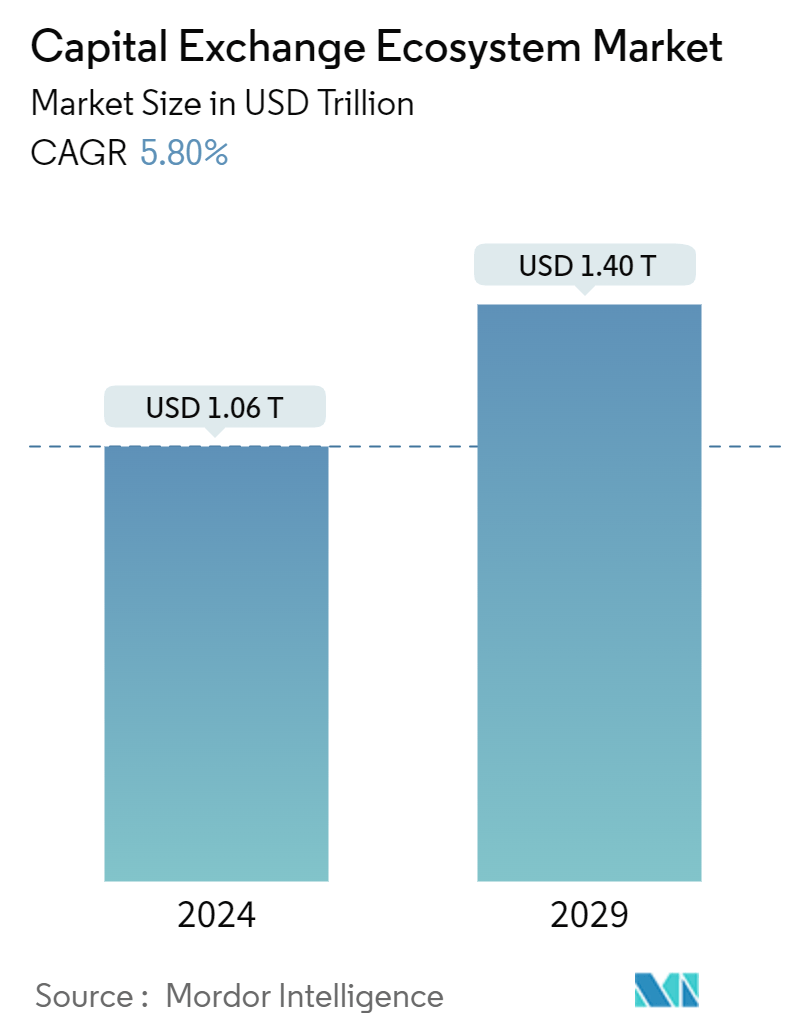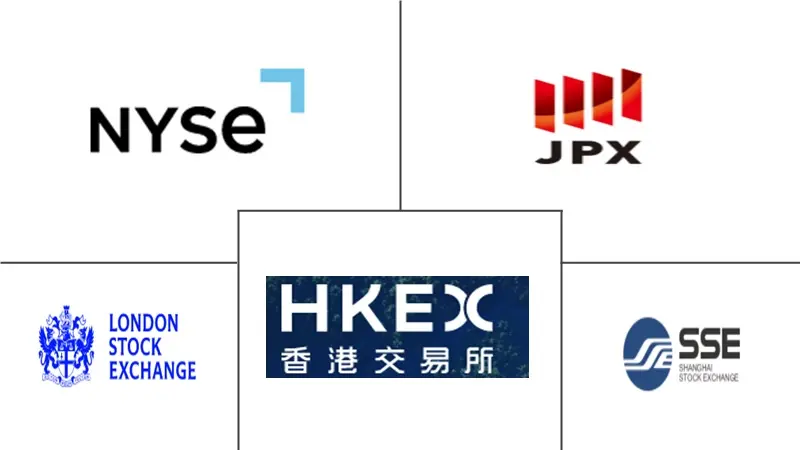Market Size of Capital Exchange Ecosystem Industry

| Study Period | 2020 - 2029 |
| Base Year For Estimation | 2023 |
| Market Size (2024) | USD 1.06 Trillion |
| Market Size (2029) | USD 1.40 Trillion |
| CAGR (2024 - 2029) | 5.80 % |
| Market Concentration | Medium |
Major Players
*Disclaimer: Major Players sorted in no particular order |
Capital Exchange Ecosystem Market Analysis
The Capital Exchange Ecosystem Market size is estimated at USD 1.06 trillion in 2024, and is expected to reach USD 1.40 trillion by 2029, growing at a CAGR of 5.80% during the forecast period (2024-2029).
Capital Market exchanges are developed to satisfy the need to raise funds for individuals, firms, and governments. The fund is generally raised through trading of funding instruments such as shares, debentures, debt instruments, bonds, ETFs, etc. Capital markets are established in stock exchanges such as the equity, debt, and options markets. Investors invest money in a firm's share or bond, bridging the gap between suppliers of capital and people in need of cash. With market risk in shares and mutual funds, risk occurs over one's investment and hinders income.
As global inflation continuously increases with a decline in the interest rate of banks and accommodative policies, earning through interest rate on deposits has fallen below the inflation rate; this trend has caused many people to invest in the Capital Market to achieve a higher interest rate.
Capital Exchange Ecosystem Industry Segmentation
The capital market consists of traded stocks, which further consists of traded securities, the mutual fund industry, and exchange-traded funds. The capital market acts as a place where financial investments can be acquired or disposed of. Stock exchanges act as a medium where these issued shares and bonds are traded.
The capital market exchange ecosystem is segmented by market composition, capital market, stock type, and bond type. By market composition, the market is sub-segmented into primary market and secondary market. By capital market, the market is sub-segmented into the stock market and bond market. By stock type, the market is sub-segmented into common and preferred stock, growth stock, value stock, defensive stock, and others. By bond type, the market is sub-segmented into government, corporate, municipal, mortgage, etc. The report offers market size and forecasts for the capital market exchange ecosystem in terms of revenue (USD) for all the above segments.
| Market Composition | |
| Primary | |
| Secondary |
| Capital Market | |
| Stocks | |
| Bonds |
| Stock Type | |
| Common and Preferred | |
| Growth Stock | |
| Value Stock | |
| Defensive stock |
| Bond Type | |
| Government | |
| Corporate | |
| Municiple | |
| Mortgage | |
| Other Bond Types |
Capital Exchange Ecosystem Market Size Summary
The Capital Exchange Ecosystem Market is poised for significant growth, driven by the increasing need for individuals, firms, and governments to raise funds through various financial instruments such as shares, debentures, and bonds. This ecosystem is supported by robust financial markets, including stock, bond, commodity, and foreign exchange markets, which facilitate the dynamic interplay of diverse participants like individual and institutional investors, traders, brokers, and financial institutions. The rise of electronic trading platforms has further transformed the landscape, enhancing market transparency and transaction efficiency. As global inflation continues to rise and bank interest rates decline, many investors are turning to capital markets to achieve higher returns, contributing to the market's expansion.
The market's growth is also reflected in the increasing issuance of shares, which has attracted more investors and boosted equity values. Notable developments include the introduction of new financial products, such as the Defiance Israel Bond ETF, which provides access to the Israeli bond market, and the significant rise in retail investor participation in exchanges like the National Stock Exchange. These trends underscore the capital exchange ecosystem's role as a vital component of the global financial landscape, offering opportunities for investment and capital raising amidst varying economic conditions.
Capital Exchange Ecosystem Market Size - Table of Contents
-
1. MARKET DYNAMICS
-
1.1 Market Overview
-
1.2 Market Drivers
-
1.2.1 Automating all processes
-
1.2.2 Regulatory Landscape
-
-
1.3 Market Restraints
-
1.3.1 Capital restrictions can slow down growth
-
-
1.4 Market Opportunities
-
1.4.1 Diversification across the value chain
-
-
1.5 Porter's Five Forces Analysis
-
1.5.1 Bargaining Power of Buyers/Consumers
-
1.5.2 Bargaining Power of Suppliers
-
1.5.3 Threat of New Entrants
-
1.5.4 Threat of Substitute Products
-
1.5.5 Intensity of Competitive Rivalry
-
-
-
2. MARKET SEGMENTATION
-
2.1 Market Composition
-
2.1.1 Primary
-
2.1.2 Secondary
-
-
2.2 Capital Market
-
2.2.1 Stocks
-
2.2.2 Bonds
-
-
2.3 Stock Type
-
2.3.1 Common and Preferred
-
2.3.2 Growth Stock
-
2.3.3 Value Stock
-
2.3.4 Defensive stock
-
-
2.4 Bond Type
-
2.4.1 Government
-
2.4.2 Corporate
-
2.4.3 Municiple
-
2.4.4 Mortgage
-
2.4.5 Other Bond Types
-
-
Capital Exchange Ecosystem Market Size FAQs
How big is the Capital Exchange Ecosystem Market?
The Capital Exchange Ecosystem Market size is expected to reach USD 1.06 trillion in 2024 and grow at a CAGR of 5.80% to reach USD 1.40 trillion by 2029.
What is the current Capital Exchange Ecosystem Market size?
In 2024, the Capital Exchange Ecosystem Market size is expected to reach USD 1.06 trillion.

